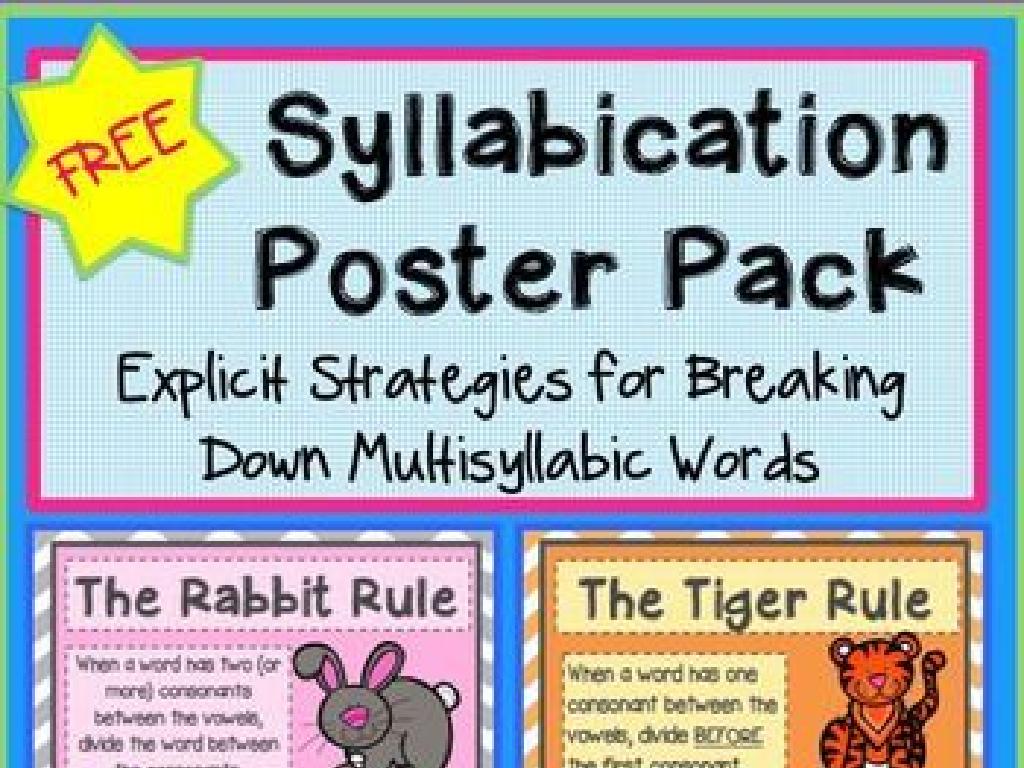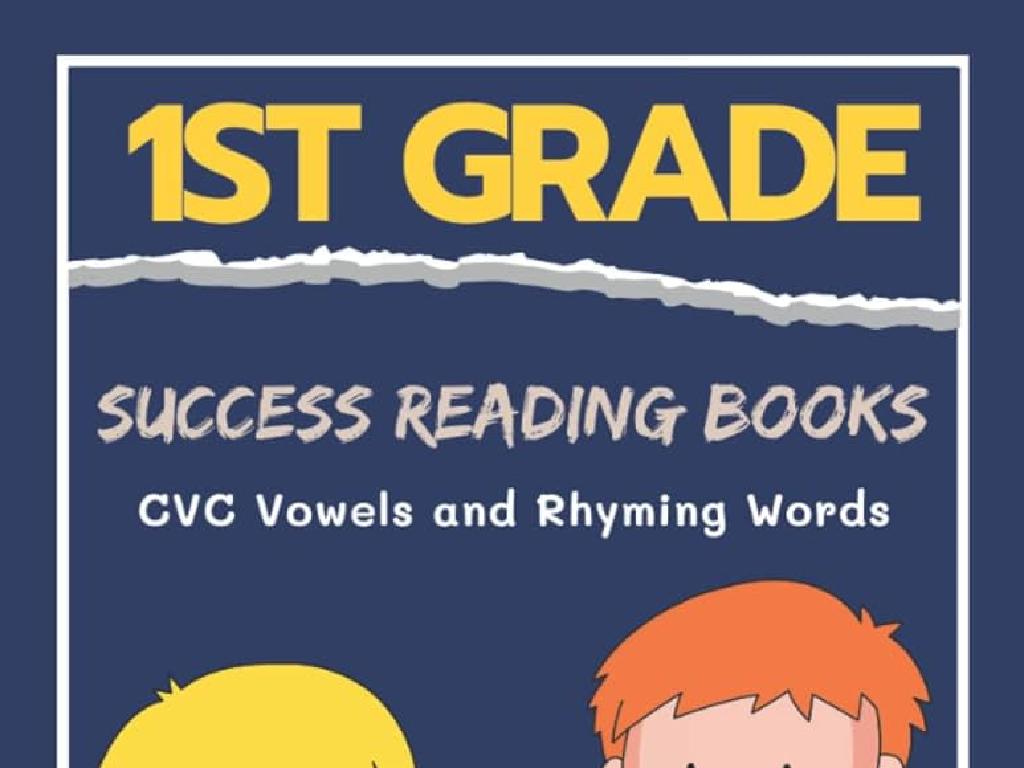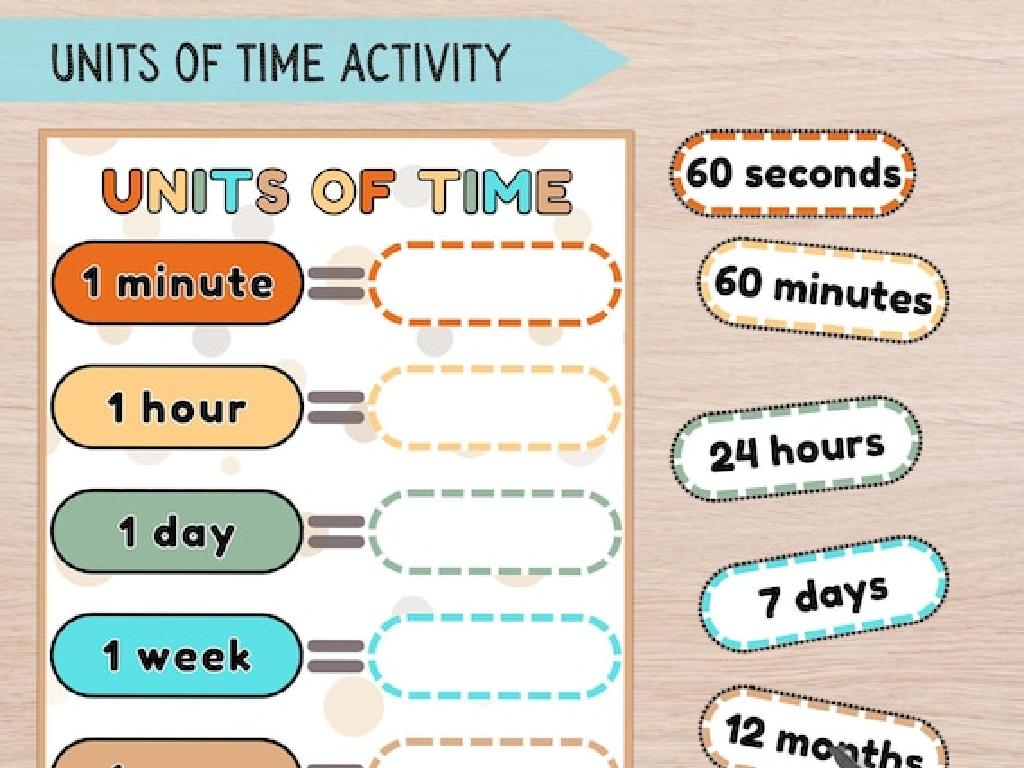Form And Use Plurals Of Compound Nouns
Subject: Language arts
Grade: Seventh grade
Topic: Nouns
Please LOG IN to download the presentation. Access is available to registered users only.
View More Content
Nouns – More than One: Compound Nouns
– Understanding compound nouns
– Two words combined to create a new meaning, e.g., ‘toothbrush’, ‘hairbrush’
– Defining plurals
– Plurals refer to more than one of something
– Forming plurals of compound nouns
– Add ‘s’ or ‘es’ to the most significant word, e.g., ‘mothers-in-law’, ‘passers-by’
– Practice with examples
– ‘Toothbrushes’ and ‘hairbrushes’ are plurals for more than one ‘toothbrush’ or ‘hairbrush’
|
This slide introduces the concept of compound nouns and their plural forms. Start by explaining that a compound noun is made up of two or more words that function as a single noun. Emphasize that when making compound nouns plural, students should add ‘s’ or ‘es’ to the word that changes in number, usually the most significant part of the compound. Provide clear examples, such as ‘mothers-in-law’ where ‘mother’ changes in number, not ‘law’. Encourage students to think of other compound nouns and practice forming their plurals. This will help them understand how to use plurals in different contexts and enhance their grammatical skills.
Plurals of Compound Nouns
– Define compound nouns
– A noun made up of two or more words combined to create a new meaning.
– Examples: Toothbrush, basketball
– Common items: toothbrush, basketball; family relation: mother-in-law.
– Types: One word, hyphenated, separate
– ‘Toothbrush’ is one word, ‘mother-in-law’ is hyphenated, ‘ice cream’ is two words.
– Forming plurals of compound nouns
– Add ‘s’ or ‘es’ to form plurals, e.g., ‘toothbrushes’, ‘mothers-in-law’.
|
This slide introduces the concept of compound nouns to the students, which are nouns made up of two or more words that function as a single unit to name a person, place, or thing. Provide clear examples to illustrate the different forms compound nouns can take: one word (toothbrush), hyphenated (mother-in-law), or two separate words (ice cream). Emphasize the rules for making compound nouns plural, which typically involves adding ‘s’ or ‘es’ to the end of the word. However, for hyphenated or separate words, the ‘s’ is usually added to the primary noun. Encourage students to think of more examples and consider how the meaning changes when the words are combined compared to when they are separate.
Forming Plurals of Compound Nouns
– Singular nouns: one item
– Plural nouns: more than one
– Making nouns plural: add ‘s’ or ‘es’
– For example, ‘bus’ becomes ‘buses’, ‘fox’ becomes ‘foxes’
– Compound nouns: special rules
– Words like ‘mother-in-law’ become ‘mothers-in-law’
|
This slide introduces the concept of singular and plural nouns, focusing on the rules for forming plurals in English. Singular nouns refer to a single entity, while plural nouns refer to multiple entities. The general rule for creating plurals is to add ‘s’ or ‘es’ to the end of the singular form. However, compound nouns follow special pluralization rules, often involving making the primary noun plural within the compound. For instance, ‘passer-by’ becomes ‘passers-by’. It’s important to provide students with a variety of examples to illustrate these rules and to encourage them to practice by identifying singular and plural forms of nouns in sentences.
Pluralizing Compound Nouns
– Pluralize one-word compounds
– Add ‘s’ or ‘es’ to words like toothbrush, e.g., toothbrushes
– Hyphenated compounds pluralization
– Add ‘s’ or ‘es’ to the significant word, e.g., mothers-in-law
– Two-word compounds plural rule
– Pluralize the main noun in phrases like ‘commander in chief’, e.g., commanders in chief
– Practice with examples
|
This slide introduces the rules for forming plurals of compound nouns. Students should learn that for one-word compounds, they typically add ‘s’ or ‘es’ to the end of the word. For hyphenated compounds, the ‘s’ or ‘es’ is added to the most significant word, which is usually the word that is being modified or is the main subject. For two-word compounds, the main noun is pluralized. It’s crucial to provide examples for each rule to ensure understanding. Encourage students to come up with additional examples and write them down for practice. This will help solidify their understanding of how to form plurals in different compound noun scenarios.
Plurals of Compound Nouns: Examples in Action
– Singular to plural: Toothbrush
– Toothbrush becomes toothbrushes
– Hyphenated plurals: Mother-in-law
– Add ‘s’ to the main word: mothers-in-law
– Two-word nouns: Full moon
– Full moon becomes full moons
– Rules for forming plurals
– Apply different rules based on compound noun types
|
This slide provides clear examples of how to form plurals from compound nouns. Students will see the transformation of a one-word compound noun (toothbrush), a hyphenated compound noun (mother-in-law), and a two-word compound noun (full moon). It’s crucial to explain that for hyphenated compounds, we add the ‘s’ to the primary noun, which is usually the second word. For two-word compounds, we typically pluralize the main noun. Encourage students to come up with additional examples and to recognize the pattern in each type for their practice.
Let’s Practice: Pluralizing Compound Nouns
– Activity: Pluralize compound nouns
– Class examples and discussion
– We’ll explore examples like ‘toothbrush’ becoming ‘toothbrushes’
– Think-Pair-Share exercise
– Think of compound nouns, discuss the plural form with a partner
– Share your examples with the class
– Present your findings to everyone
|
This slide introduces an interactive class activity focused on forming plurals of compound nouns. Begin by explaining the concept with clear examples, then engage the class in identifying compound nouns and converting them to their plural forms. For the Think-Pair-Share activity, students will independently think of compound nouns, pair up with classmates to discuss their plural forms, and then share their examples with the class. This collaborative exercise not only reinforces the lesson but also promotes communication skills. As a teacher, facilitate the discussion, correct misconceptions, and provide feedback. Possible activities: 1) Students list household items that are compound nouns and pluralize them. 2) Create a story using plural compound nouns. 3) Find compound nouns in a given paragraph and write their plural forms. 4) Use flashcards with singular compound nouns for students to convert to plural.
Class Activity: Pluralizing Compound Nouns
– Invent new compound nouns
– Collaborate in groups for a list
– Make your nouns plural
– Add ‘s’ or ‘es’, change ‘y’ to ‘ies’, or rewrite the word if irregular
– Share with the class
– Choose the most creative one for presentation
|
This activity is designed to engage students with the concept of compound nouns and their plural forms. Divide the class into small groups and instruct them to create a list of original compound nouns. Then, guide them to apply the rules for making these nouns plural, which may include adding ‘s’ or ‘es’, changing ‘y’ to ‘ies’, or altering the word in the case of irregular nouns. Encourage creativity and collaboration. After the group work, each group will select their most creative compound noun and present its singular and plural forms to the class. This will help reinforce their understanding of the concept and allow them to practice public speaking. Possible activities could include creating compound nouns based on objects in the classroom, combining animals and objects, or inventing new items that could exist in the future.
Review and Homework: Plural Compound Nouns
– Recap today’s compound nouns lesson
– Homework: 10 sentences with plural compound nouns
– Use nouns like ‘toothbrushes’, ‘sisters-in-law’, ‘passers-by’
– Study for the upcoming compound nouns quiz
– Practice makes perfect!
– The more you practice, the better you’ll understand!
|
As we conclude today’s lesson on plural compound nouns, provide a brief review of the key points. For homework, students are to write 10 sentences that include plural compound nouns, which will help reinforce their understanding. Encourage creativity and correct usage of the nouns in context. Remind students to prepare for the quiz by reviewing their notes and the homework assignment. Emphasize the importance of practice in mastering the use of compound nouns in both singular and plural forms. Offer additional examples and encourage students to ask questions if they’re unsure about the pluralization rules.






